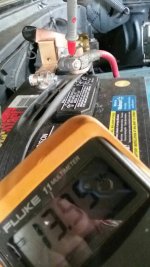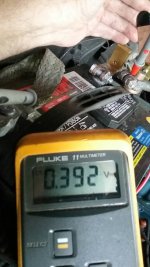Fuddy1952
Elite Member
- Joined
- Apr 17, 2018
- Messages
- 4,332
- Location
- South Central Virginia
- Tractor
- 1973 Economy and 2018 John Deere 3038E
Maybe this will help.
As an electronic technician I have lots of meters, including Dad's Simpson 230.
All voltmeters draw current called input impedance (resistance) measured in ohms per volt. The Simpson meter in 1K (1000) ohms per volt. The other extreme is this Fluke 11, input impedance is 10M (10,000,000) ohms/volt.
The cornerstone of electricity/electronics is ohms law. E=IR, E (voltage)=I (current) times resistance.
If you know two things you can figure out the third. A 24 ohm resistance across a 12 volt battery = 1/2 amp (500mA). As resistance increases, current drops.
The higher the voltage the thicker insulation needs to be like spark plug wires.
Strange things happen in the area between a good/poor conductor and proper insulation. A good new battery can drain if there is moisture or conductivity post to post. Stray or ghost voltages and current drains can occur with even a slight imperfection, moisture, poor connection, corrosion or poor insulation.
In pictures you see a few analog and digital meters all with the same 13.09 VDC source and effect of measuring across my finger (skin resistance) dry and wet with water.
The Fluke meter voltmeter reads the same voltage even with one lead measuring across my finger because it's input impedance is so high.
You can disconnect a battery lead, put an ammeter in series to measure a current draw, then watch the reading change if you spray water around different areas. 12 volts is not high enough to shock you with clean dry hands, it will shock if you've ever had one wet hand on a good ground, the other in a wet wash mitt on positive terminal.

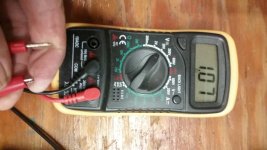
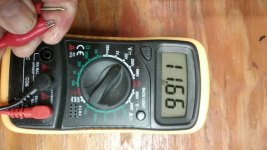
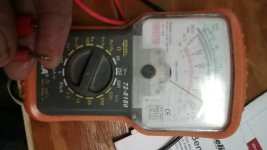
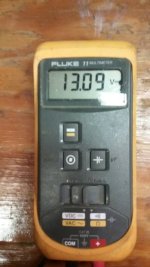
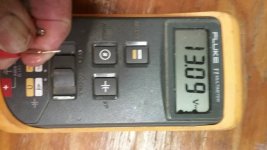
As an electronic technician I have lots of meters, including Dad's Simpson 230.
All voltmeters draw current called input impedance (resistance) measured in ohms per volt. The Simpson meter in 1K (1000) ohms per volt. The other extreme is this Fluke 11, input impedance is 10M (10,000,000) ohms/volt.
The cornerstone of electricity/electronics is ohms law. E=IR, E (voltage)=I (current) times resistance.
If you know two things you can figure out the third. A 24 ohm resistance across a 12 volt battery = 1/2 amp (500mA). As resistance increases, current drops.
The higher the voltage the thicker insulation needs to be like spark plug wires.
Strange things happen in the area between a good/poor conductor and proper insulation. A good new battery can drain if there is moisture or conductivity post to post. Stray or ghost voltages and current drains can occur with even a slight imperfection, moisture, poor connection, corrosion or poor insulation.
In pictures you see a few analog and digital meters all with the same 13.09 VDC source and effect of measuring across my finger (skin resistance) dry and wet with water.
The Fluke meter voltmeter reads the same voltage even with one lead measuring across my finger because it's input impedance is so high.
You can disconnect a battery lead, put an ammeter in series to measure a current draw, then watch the reading change if you spray water around different areas. 12 volts is not high enough to shock you with clean dry hands, it will shock if you've ever had one wet hand on a good ground, the other in a wet wash mitt on positive terminal.







